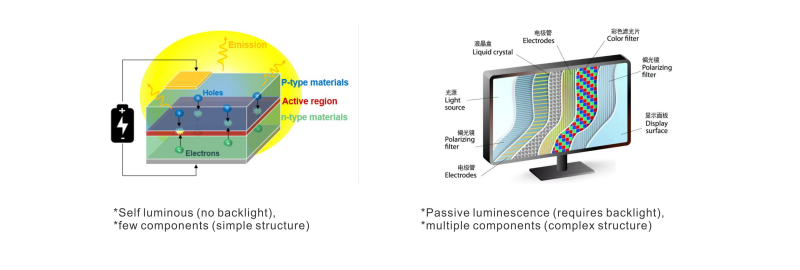LED screen and LCD splicing screen are two commonly used large screen products.
But what are the differences between them?
Differences in luminous methods
LCD: Passive illumination (requires backlight), multiple components (complex structure)
LED: Self luminous (no backlight), few components (simple structure)
Firstly, LED screens are composed of a type of light-emitting diode, which is packaged into LED chips and then emits light.
On the other hand, LCD screens emit light through a combination of LED backlight and LCD modules, which have essential differences in their emission methods.

Resolution difference
If compared, LCD screens have a higher resolution than LED screens, which is a consistent advantage of LCD screens.
The resolution of one screen can reach 1920 * 1080, and after splicing, it can achieve 4K or higher resolution.
Therefore, when displaying images, LCD screens display very clearly without any blurring. The resolution of an LED screen is determined by the number and spacing of the LED beads.
The smaller the LED beads, the higher the resolution, and overall, the resolution is not as high as that of an LCD screen.

Brightness difference
Due to the fact that the LED beads are exposed on the surface and do not emit backlight like LCD screens, their brightness is higher.
When used outdoors in strong light environments, LED screens will not cause reflective issues.

Differences in splicing effects
The difference in splicing effect here mainly refers to the splicing seam.
LED screens have no splicing seam no matter how they are spliced, while LCD splicing screens will have a few millimeters of physical border after splicing, forming a splicing seam.
If compared from the full screen effect, the difference is still very obvious, and LED full screen effect is more complete.

Differences in installation environment
In practical applications, LED screens can be installed outdoors or indoors because they have the advantages of waterproofing, sun protection, and high adjustable brightness, so there is no restriction on the installation environment.
LCD screens, on the other hand, can only be used indoors because they do not achieve such high brightness, are prone to reflection when used outdoors, and are not waterproof.
Due to the differences in installation environments and display characteristics between LED screens and LCD screens, their specific uses are also different.
LED screens are mainly used for full screen advertising and information dissemination occasions, such as exhibition halls and advertising screens, while LCD splicing screens are mainly used in monitoring rooms, command centers, and conference rooms.
LEGIDATECH & EXCEL LED
When choosing, we need to analyze it specifically based on the desired effect and usage environment.
Author: Jason Ouyang
FAQs:
- What is LED?
LED display screen is a new type of imaging electronic device made by arranging light-emitting diodes in sequence. Due to its high brightness, wide viewing angle, and long lifespan, it is widely used in outdoor advertising screens and other products.
LED display screens are generally used to display various information such as text, images, videos, and video signals. They not only integrate information dissemination, cultural and entertainment, and promotion functions, but also serve as a new type of high-tech product.
With its rich technological content, surging appearance, smooth display of images, and delicate color expression, they can add a new vitality to the environment and build a lively landscape, Now it has become the primary choice for corporate promotion
- What is LCD?
LCD (Liquid Crystal Display) is the abbreviation for Liquid Crystal Display. The structure of LCD is to place liquid crystals in two parallel pieces of glass, with many small vertical and horizontal wires between the two pieces of glass. The direction of the rod-shaped crystal molecules is controlled by whether they are electrified or not, and the light is refracted to produce a picture.
3、What is the biggest advantage of LED compared to LCD?
More energy-efficient, high brightness, seamless splicing, longer lifespan, and wider application scenarios
4.What is the lifespan of LED?
People call LED light sources longevity lamps. It is a solid cold light source, encapsulated in epoxy resin, and there is no loose part inside the lamp body. There are no disadvantages such as easy burning of the filament, thermal deposition, and light decay. Under appropriate current and voltage, the service life can reach 60000 to 100000 hours, which is more than 10 times longer than the traditional light source.
From the normal use of LED, the main factor affecting the lifespan of LED is heat. The sources of heat include Joule heat generated by the normal resistance of the material when electrified, heat generated by the PN junction, Joule heat generated by parasitic resistance in the process, and heat generated by the attraction of light. The accumulation of heat causes an increase in temperature, which in turn leads to performance degradation, aging, and denaturation of the chip.




